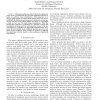Free Online Productivity Tools
i2Speak
i2Symbol
i2OCR
iTex2Img
iWeb2Print
iWeb2Shot
i2Type
iPdf2Split
iPdf2Merge
i2Bopomofo
i2Arabic
i2Style
i2Image
i2PDF
iLatex2Rtf
Sci2ools
ICRA
1998
IEEE
1998
IEEE
Selecting Targets for Local Reference Frames
This paper addresses the problem of seeking out parts of the environment that provide adequate features in order to perform robot localization. The objective is to choose good regions in which local metric maps can be established. A distinctiveness measure is defined as a measure of how well the environment allows the robot to accomplish a task, in our case the task being localization. The distinctiveness measure is evaluated as a function of both the localization strategy and the environment. Areas in the environment are considered to have high distinctiveness measures if they exhibit both sufficient spatial structure and good sensor feedback. The problem is treated as defining an evaluation criterion based on the usefulness of gathered information.
Related Content
| Added | 04 Aug 2010 |
| Updated | 04 Aug 2010 |
| Type | Conference |
| Year | 1998 |
| Where | ICRA |
| Authors | Saul Simhon, Gregory Dudek |
Comments (0)

